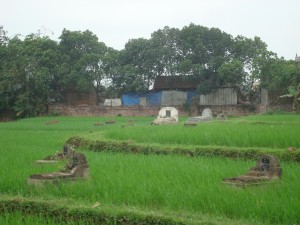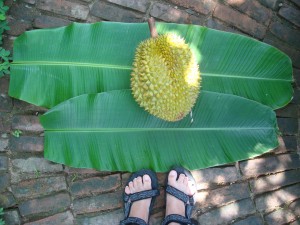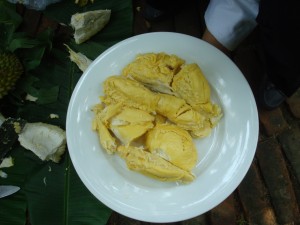The last two weeks went by very quickly. We met up with Mark’s parents, Don and Ann, in mid-March, and we started the “official tour” part of our trip, complete with guides, a private van, and bed bug free hotels – and lots of food. And no more Facebook access, as it was blocked everywhere else we went in Vietnam.
On our drive from Halong Bay to the Hanoi airport, we made a stop in a local village known for its pottery. Specifically, making ceramic coffins. Our guide, Thuy (pronounced “Twee”) educated us about the Vietnamese custom of burying their dead. When a person dies, they are buried in a coffin for three years. After three years, the coffin is opened, the bones are washed, and then moved into a small ceramic coffin where they remain forever. It’s bad luck to move the bones, and as we drove by rice paddies and fields we could see many graves in the middle of rice paddies. We wondered if there’s an expression like “pushing up rice” instead of “pushing up daisies” in Vietnamese culture?

Tombs in rice paddies
Hue was a welcome relief after the chilliness of Hanoi. The city is the ancient capitol of Vietnam, and is the religious and culinary center today. One of our favorite experiences in Hue was visiting the local market with Mai, a chef from the Ancient Hue restaurant. We took a cooking class with Mai later in the day, and we were shopping for our class. There’s a lot of very weird-looking stuff in the markets, and it was fun (and eye-opening) to have somebody to answer all our questions. There are a lot of things you can do with pig and tofu that we were not aware of!
Our best market find was the fabled durian fruit. The durian is known for its odor – fragrant to some, and highly offensive to others. The smell is so pungent that the fruit is banned from public transportation and is not allowed in many hotels. One of our hotels had only three rules, one of which was “Guests cannot have durian fruit in their rooms”. Of course we wanted to try it.

Our durian fruit (and Mark's feet)
Mai helped us negotiate for a 4 kg. fruit ($10 US), and Mark got the honor of carrying the bag back to our van. Mark got a lot of attention – people stared, some with envy and several with wrinkled noses as he hoisted the bag. Mai later told us that a four kilogram durian is really big, and 1-2 kg. fruit are more common.
We took the fruit back to the Ancient Hue restaurant, where one of the chefs put it in a wine bucket outside. Our responses to the odor varied. Don thought it smelled like something dead, Ann found it highly disagreeable, Mark likened it to an overripe papaya, and it reminded me of a ripe cantaloupe.
Opening the durian was no easy task. It took two men, a long sharp knife, an even bigger long sharp knife, and 15 minutes to get to the fruit. And here it is!

Durian fruit, the edible part
We all tasted it, and responses to the taste were mostly in line with responses to the odor. Don and Ann thought it was disgusting, Mark thought it was okay, and I thought it tasted pretty good, a little like fruity custard. Mark and I both noticed a weird onion aftertaste. While we wouldn’t go out of our way to have durian again, it was fun to try it.
From Hue we went to the beach town of Nha Trang, where we met up with Mark’s sister, Jodi, and her boyfriend Paul. We had no official touring plans in Nha Trang, which turned out to be a good thing as Don, Paul and I all got sick. We had different symptoms, and fell ill on different days. This is where traveling with retired medical professionals really came in handy, as Don and Ann had a treasure chest of drugs, and we were able to self-medicate quickly. Yay for Cipro!
Nha Trang is also a great place to dive, and Mark and I went on a two-dive day trip with Octopus Diving. We were lucky to get Tahn as our divemaster, as he pointed out things we would have never seen on our own, and that most of the other groups didn’t see, including our first octopus, two enormous jellyfish, and two sea turtles.
From Nha Trang we drove to Dalat, a scenic drive from the beach to the highlands. Dalat was a beautiful town with a lot of French colonial architecture. Plants there were similar to what we see at home: hydrangea, almond trees, pansies…even artichokes! The big industry in Dalat is flowers, and there were hundreds of greenhouses across the hills.
We only stayed one night in Dalat (illness kept us an extra night in Nha Trang), but Ann and I managed to find a silk shop where we both bought meters of gorgeous silk…recommendations for a great tailor are welcome!
From Dalat we flew to Saigon/Ho Chi Minh City. We expected the traffic to be crazy in Saigon after hearing stories from other travelers, but we didn’t find it nearly as bad as the traffic in Hanoi. While there were a lot more motorbikes in Saigon, drivers actually paid attention to the traffic signals, so it was much easier to cross roads. We also learned one reason why there were so many motorbikes and so few cars: the Vietnam government taxes cars at 250%! So if a car costs $20K, you pay $50K once tax is added. Ouch.
More on Saigon in our next post! Sorry we’re lagging a bit on posting and uploading photos. Internet connections are slow, so we’re not online so much.
About our tour: Trails of Indochina was our tour operator, and they rocked. Highly, highly recommend if you’re looking for a customized private tour of SE Asia. Great guides, great experiences, lots of insights and education. Don and Ann organized the trip with them through John Stewart Bowerman at Cardoza-Bungey Travel. 12 thumbs up!